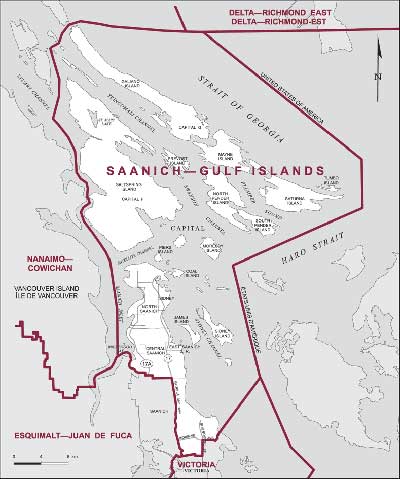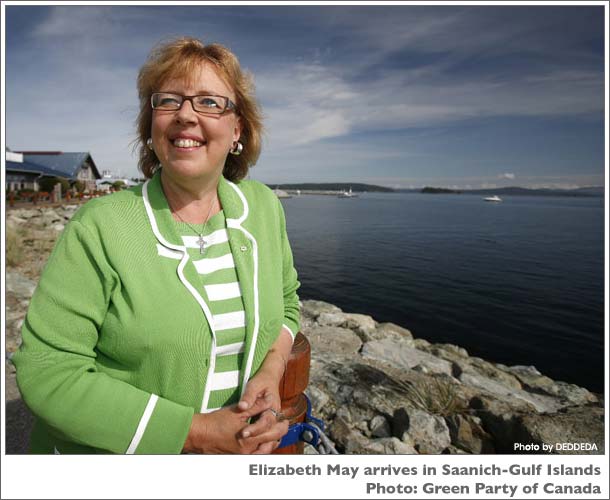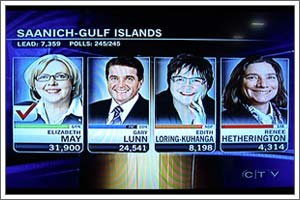Elizabeth May and the Canadian Greens Make History
Share

by Camille Labchuk, Green Party of Canada Federal Councillor and former Press Secretary to Elizabeth May and Jordy Gold, Elizabeth May Deputy Campaign Manager
On May 2, British Columbians made history by electing Elizabeth May the first elected Green Member of Canadian Parliament, ousting a 14-year incumbent and sitting cabinet minister in the Conservative Party government. May joins the ranks of a small, but growing, number of Green politicians who have broken through and won at the national level under first-past-the-post voting. How did this occur?
In August of 2006, May, a well-known and media-savvy environmentalist, lawyer and author was elected Leader of the Green Party of Canada, bringing a high profile to the party. Less than two months later, a by-election (special election) was called in Ontario. May shocked pundits and the Canadian public, finishing second with an unprecedented 26 percent of the vote — more than any Green in Canada’s history.
In the lead up to the next federal general election in September 2008, May announced that she would seek a seat in Central Nova, a primarily rural riding in Nova Scotia. She spent less than half of her time there and the rest touring the country raising the party’s profile in support of other Green candidates. She also participated in the televised national leaders’ debates — a first for the Greens. Originally excluded, public outcry forced the TV executives (and some other party leaders, who wanted her kept out) to reverse their decision.
Nationally Greens garnered nearly 7 percent of the national vote but failed to win a seat. May won a record-breaking 32 percent, but not enough to steal the seat from the incumbent Conservative, who happened to be the Minister of National Defence.
 The 2008 election gave the Greens much to think about. The party’s Federal Council adopted a new strategy for the next election, prioritizing electing the leader to Parliament. This had two critical components. First, identifying the best possible riding for Elizabeth May. Second, devoting the pre-election resources and energy necessary for her to win. After extensive polling and consultations in Spring 2009, it was clear that Saanich—Gulf Islands (SGI) in British Colombia (BC) was the best option in the country.
The 2008 election gave the Greens much to think about. The party’s Federal Council adopted a new strategy for the next election, prioritizing electing the leader to Parliament. This had two critical components. First, identifying the best possible riding for Elizabeth May. Second, devoting the pre-election resources and energy necessary for her to win. After extensive polling and consultations in Spring 2009, it was clear that Saanich—Gulf Islands (SGI) in British Colombia (BC) was the best option in the country.
The West Coast is Green-friendly territory. The Green Party of BC was the first in North America, founded by current Green Party of Canada Deputy Leader Adriane Carr in 1983, and as a result, Green politics have been on the radar for decades in BC. Environmental protection is a hot issue there and British Columbians are used to considering the Greens as a viable alternative to the old-line parties and had already elected many Greens to municipal governments. With a Green base established and other capable, Green-friendly groups present, running in SGI provided the possibility of attracting a range of high quality volunteers.
SGI was also already one of the greenest ridings in Canada, comprised of voters from the suburbs of the city of Victoria, as well as residents of the Gulf Islands, accessible only by ferry. Voters there gave Green Andrew Lewis 17 percent of the vote in 2004 — the best federal result to that date. Provincially, Lewis won over 25 percent in 2001. In recognition of the popularity of the Greens in SGI, the Liberals and NDP had recruited former Green activists as candidates in the 2008 election — a clear indication SGI voters hold Green values and issues near and dear.
SGI traditionally also has some of the highest voter turnout in the country (second only to Prince Edward Island in 2001.) We believed that if could maximize voter turnout, pull key traditional Conservative voters who are either frustrated with the local candidate or the Conservative party leader, and unify a large percentage of voters under one banner, we could win. In retrospect, we did just this.
Also relevant was the strong anti-Conservative sentiment. Conservative cabinet minister Gary Lunn had held the riding since 1997, only because progressive voters were split between the Liberals, New Democrats and Greens. Progressives in the riding had acknowledged the problem and launched a Shun Lunn campaign, encouraging voters to rally around one of Lunn’s opponents to vote him out. Introducing May brought a rallying point for both progressive voters and traditional Conservatives who were frustrated with the direction of the Conservative government. In her two previous campaigns, May had easily built support among voters who usually supported other parties, and we expected the trend would continue in SGI.
The initial response was incredibly positive, but we had to work hard to build her profile among non-Greens. Not everyone knew of her great work, or was certain she was not a “parachute candidate”. Although it is not legally necessary that a candidate live in the riding, it made a huge difference that she moved to SGI and became integrated into the community for a year and a half before the election was called. This allowed her team to knock on thousands of doors and interact with the same voters many times. Her charisma and genuineness made it difficult to meet her and not want to vote for her.
We worked hard to dispel the party’s “one-issue” reputation, demonstrate that we were electable. Grassroots organizing ultimately made it possible,and bring the majority on board who had never voted for the party in the past. Meet-and-greets in peoples’ homes were essential and we won over supporters of all ages and who had traditionally not voted at all or not for the Green Party. Powerful unions, left-wing progressives and major strategic voting website endorsed May, as did right-wing media commentators and even high-profile former Conservative Party members.
The Conservative government fell in late March, and we moved into full campaign mode immediately. May ran a shorter and more focused leader’s tour. Spending 10 days on tour out of a 36 day campaign allowed May to maximize the time she spent in SGI.
Then, a result of deliberate and concerted collusion between the corporate media and the other political parties, the TV networks excluded May from the televised leaders’ debates, despite her participating in 2008. There was outrage from the overwhelming majority of voters, rallies in major centers across the country, and an emergency legal challenge, but the anti-democratic decision of the networks was allowed to stand and debates went ahead without May and this hurt our national vote. But this may have helped the SGI campaign as voters wanted to hear what May had to say and were prepared to vote for her to make sure she had a chance to speak on the national stage.
As May is a tremendous speaker and fabulous debater, we were determined to showcase this in the ten-plus local debates. Debate halls were consistently packed — some with over 1000 people — and May received multiple standing ovations, sometimes simply for entering the room.
SGI has a history of dirty electoral tricks from the old-line parties, so May was determined to run a clean campaign and hoped for everyone to play by the rules. This atmosphere was helped by reports of Green Party volunteers fixing up damaged signs from all parties.
We knew the campaign was going well when people randomly began their own initiatives, from the kids who made their own lawn signs, to the artist that created the “Yes We May” posters as a takeoff on Obama’s “Yes We Can”, or the individuals who parked on main streets with homemade posters on their cars and trucks. As much as we were running a strong campaign, the positivity was out of our control.
Late in the campaign, we released a poll. We knew, pre-election, that we were competitive, but additional polling during the writ period did not come through until the mid-way point in the campaign. When we saw the numbers we nearly hit the floor – May in first place with 45 percent, and Lunn second at 35 percent. Although we had concerns that some might be de-motivated to vote if they thought May was going to win handily, we decided it was more important to prove that she could be elected, and we reminded people we were in a close race and their vote could make the difference.
We never took anything for granted throughout the campaign and that did not change on election day. Our get-out-the-vote effort was a success, due to a team of competent staff and high quality, committed volunteers on the ground in SGI and on phone lines across the country making calls to the riding to ensure we got out our identified vote, and to encourage as many as possible to vote — a strategy known as “pulling from strength,” knowing that in most areas, most people wanted to defeat the Conservative incumbent, and the more we increasted turnout, the better things would be.
SGI would be one of the last ridings in the country to declare a result, and as such, we were on pins and needles. But barely an hour after polls closed, with only 20 of 200+ polls reporting reporting, Lunn called May personally to graciously concede defeat and congratulate her on the victory. Soon afterwards, the national networks began announcing that May had won with over 46 percent of the vote and the crowd went wild. Not only were Green supporters thrilled, but phone calls and Twitter messages from non-Greens across the country came to us, universally expressing elation the Greens had finally elected an MP.
What’s Next?
In the brief time the House of Commons sat after May was elected, she has established the Greens as principled, yet pragmatic, as the sole dissenting voice on a vote to extend Canada’s mission in Libya, and denying unanimous consent to fast-track legislation affecting fundamental rights protections in criminal trials, With just one MP, the Greens are breaking down the psychological barrier that some have to voting Green. The next general election isn’t until 2015, but we may have the chance to elect Greens through by-elections before then. Now it’s time to start building to add to the Green caucus.
For more information, see the expanded series detailing the historic election win of Elizabeth May, written by Camille Labchuk and Jordy Gold at www.CamilleLabchuk.ca and www.JordyGold.com
10 Lessons Learned
- Saanich-Gulf Islands was without a doubt ‘the’ riding for the Greens to make their breakthrough
- There is no substitute for an extraordinary candidate and an informed, engaged, courageous electorate
- Nothing works better than genuinely listening/responding and person-to-person engagement
- Confirmed that you win elections between elections and focussing on one riding to begin, is essential
- Actions speak louder than words and there is no substitute for hard work and demonstrating consistent long-term comittment
- Champions who previously supported other parties are worth their weight in gold
- At least in the case of SGI, if not across Canada, people are sick of negative politics and will gladly get behind a strong candidate and platform that are positive and demonstrate vision
- Past election results are informative but are not necessarily indicitive of future results
- Greens pull votes from right across the spectrum
- Greens are no doubt electable, even in our antiquated First Past the Post electoral system










I think the biggest factor here is May herself. She really is an intelligent and well-informed speaker. I saw her speak once at a non-political event I was very impressed with her depth and breadth of knowledge (and also her poise when some audience-members tried to make things political in the question period).